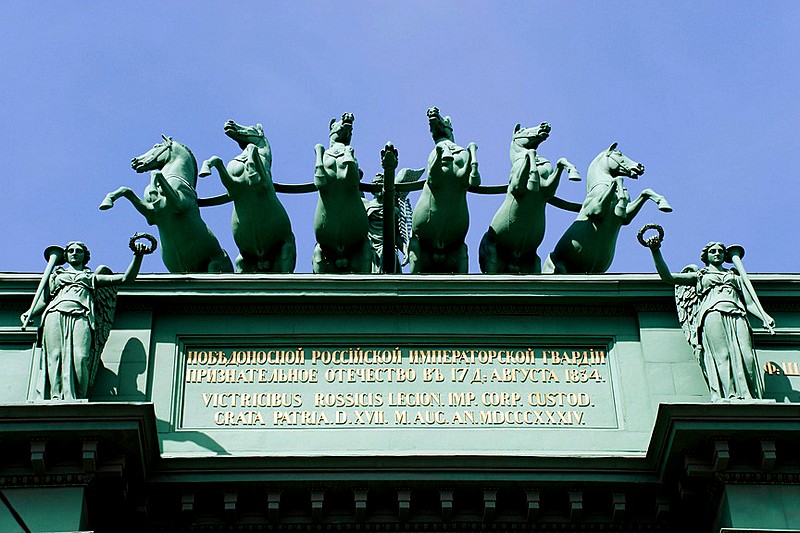The Narva Triumphal Arch
The Narva Triumphal Arch was erected as a memorial to the war of 1812. A wooden triumphal arch designed according to the plan of famous Italian classical architect Dzhakomo Quarenghi. Quarenghi also built the Concert Hall pavilion (1782-88), Alexander Palace in Pushkin (1792-1800) and the Smolny Institute (1806-08) in St. Petersburg. The Narva Triumphal Arch was specially constructed on the Narva highway to greet the soldiers who were returning from abroad after their victory over Napoleon. The arch was located approximately halfway between Ploshchad Stachek and Obvodny Canal.

In the 1820's famous Russian architect Vasily Stasov took Quarenghi's dilapidated wooden arch construction and redeveloped it while at the same time preserving the essence of Quarenghi's original composition. A place was selected for Stasov's arch on the Peterhof road close to the bridge across the Tarakanovka River. The river has since been filled in. On August 26, 1827 celebrating the 15th year anniversary of the Battle of Borodino, ground was broken at the site of the new arch in the presence of officers, soldiers and veterans of the war of 1812.
However, construction on the new arch essentially began in the 1830's after a long debate about what material to use for the facade of the new arch. Stasov suggested building the arch from brick and using sheets of copper for the facade. His idea was innovative in Russian and Western European construction circles at the time. The copper facade sheets, ornament and sculpture details from copper and arch decorations were produced at a local factory. Construction was completed on the arch in the fall of 1833, but it was officially opened one year later on August 17, 1834.

The single bay triumphal arch's composition is similar to the ancient Roman triumphal arches, which were normally built on a square near an entry to the city.
Stasov drew heavily on the great historical nature of the arch - the victory over Napoleon in the war of 1812 - in his masterly use of decorations and sculpture for the arch.
The arch is topped off with an impressive triumphal chariot pulled by six ponies. The chariot and ponies are made of hammered copper according to the model of Russian sculptor Peter Klodt. The statue of victory laurel wreath, which is held in the extended hand of a graceful and powerful female figure standing on the chariot, was molded according to the model of Russian sculptor Stepan Pimenov. The impressive and ornate models of wings of allegorical figures installed over the columns were done by Russian sculptors M. Krilov and N. Tokarev.

The two statues of ancient Russian warriors were made from hammered copper according to the model of Pimenov and V. Demut-Malinovskiy. I. Leppe created the models of the winged female figures in the arch, which personify glory.
Plans to build a museum in memory of the victory over Napoleon in the war of 1812 in the chamber above the arch have yet to be realized.
During WWII the arch suffered serious damage, but was carefully restored to its present condition in 1951.
Location: Ploshchad Stachek.

